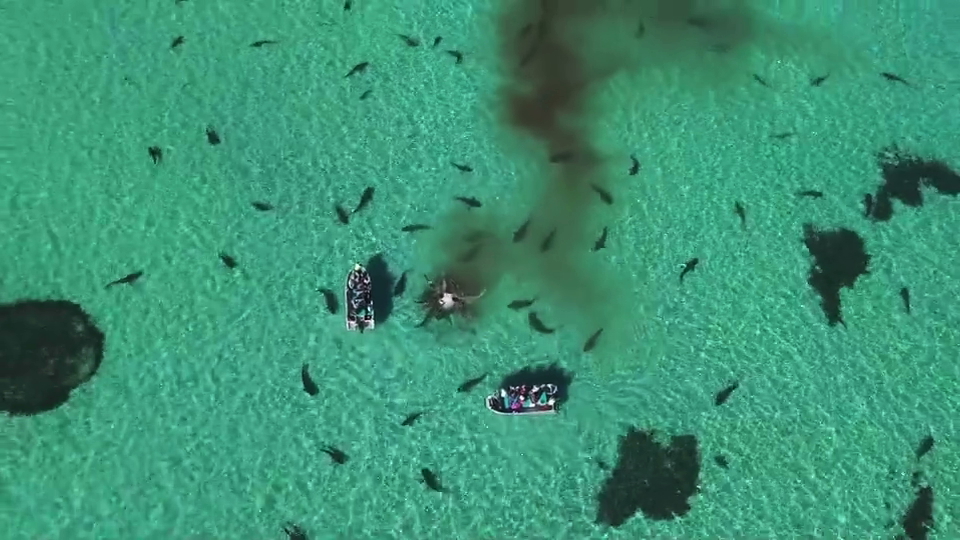Shark Bay Bloodbath: 70 Sharks Devour a Humpback Whale

On May 20, tourists on an Australian cruise witnessed an incredible but gruesome sight: approximately 70 tiger sharks tearing apart the carcass of a humpback whale in Shark Bay.
The tour company, Eco Abrolhos, encountered the bloody scene during the fourth day of a 14-day cruise, as the group traveled near Steep Point, Dirk Hartog Island, according to a post on the company's Facebook page. They used an aerial drone to capture footage of the carnage and shared the video on Facebook, showing scores of tiger sharks circling and ripping into the dead whale, as clouds of gore stained the turquoise water.
The sharks were described as having "a whale of a time."
In an earlier image that Eco Abrolhos shared on Facebook before posting the video, a group of sharks clustered around the whale carcass, close enough to the boat — and the photographer — that they appear no more than an arm's length away.
The video has accrued more than 850,000 views since it was shared on May 21.
Shark Bay is a United Nations Educational, Scientific and Cultural Organization (UNESCO) World Heritage site on the western coast of Australia. Its waters, islands and peninsulas cover approximately 5.4 million acres (2.2 million hectares) and host diverse communities of plants, amphibians, land mammals and marine life.
Shark Bay earned its name in 1699, after English explorer William Dampier visited the region and was deeply impressed by the number of sharks he observed there. He also pronounced those sharks to be delicious, according to Australia's Department of Parks and Wildlife.
Sign up for the Live Science daily newsletter now
Get the world’s most fascinating discoveries delivered straight to your inbox.
But in the May 21 video, it was whale that was on the menu. Increasingly, humpback whales and southern right whales have been using Shark Bay as a stopping point along their migratory routes, UNESCO explained in a site description. While the tour guides were unable to tell how the whale got there or describe the circumstances surrounding its death, the sight of the feeding frenzy likely will not be forgotten anytime soon — by the tourists who witnessed it firsthand, or by the hundreds of thousands of people who glimpsed it on video.
Follow Mindy Weisberger on Twitter and Google+. Follow us @livescience, Facebook & Google+. Original article on Live Science.

Mindy Weisberger is an editor at Scholastic and a former Live Science channel editor and senior writer. She has reported on general science, covering climate change, paleontology, biology and space. Mindy studied film at Columbia University; prior to Live Science she produced, wrote and directed media for the American Museum of Natural History in New York City. Her videos about dinosaurs, astrophysics, biodiversity and evolution appear in museums and science centers worldwide, earning awards such as the CINE Golden Eagle and the Communicator Award of Excellence. Her writing has also appeared in Scientific American, The Washington Post and How It Works Magazine. Her book "Rise of the Zombie Bugs: The Surprising Science of Parasitic Mind Control" will be published in spring 2025 by Johns Hopkins University Press.










